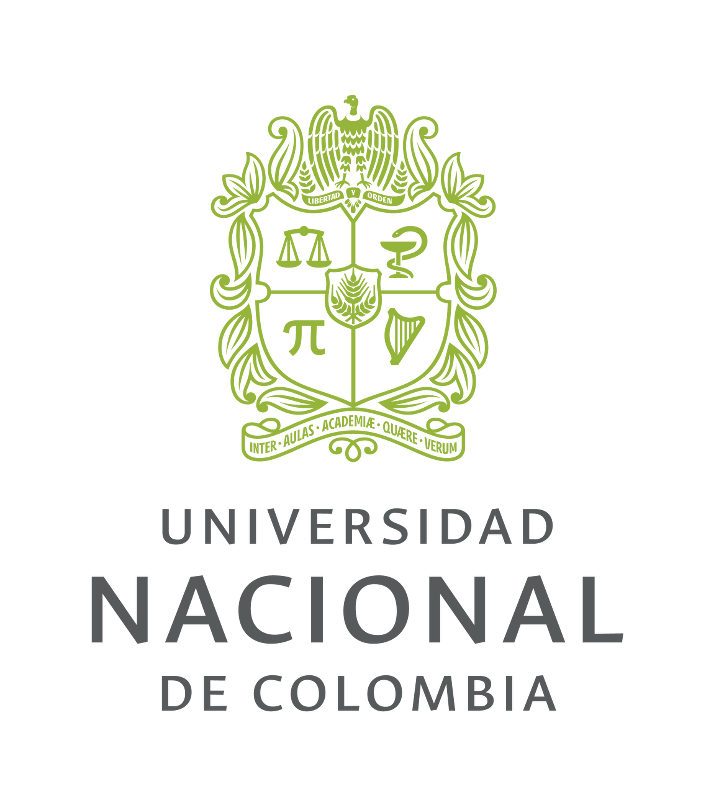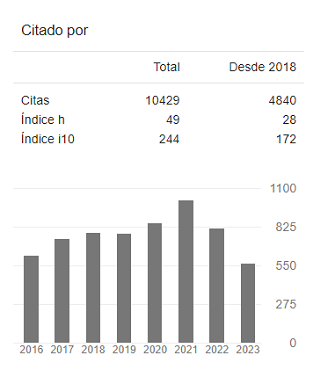Recibido: 12 de diciembre de 2022; Aceptado: 30 de noviembre de 2023; : 9 de enero de 2024
Abstract
The Brazilian Cerrado is undergoing important changes. It is estimated that 70% of its natural area has converted to human use. The loss and fragmentation of natural habitats is considered the main cause of species loss in ecosystems. However, the lack of knowledge of biodiversity makes it difficult to design effective conservation measures. This article presents a list and an estimate of the richness of bats in the Parque Estadual Altamiro de Moura Pacheco (PEAMP) in Goiás. All collected bats belong to the Phyllostomidae family, with Carollia perspicillata (67%) and Artibeus planirostris (18%) representing 86% of the captured individuals.
Keywords:
biodiversity, Cerrado, Chiroptera, bats, mammals.Resumen
El Cerrado brasileño está experimentando cambios importantes. Se estima que el 70 % de su área natural se ha transformado para uso humano. La pérdida y fragmentación de hábitats naturales se considera la principal causa de pérdida de especies en los ecosistemas. Sin embargo, la falta de conocimiento de la biodiversidad dificulta la creación de medidas de conservación efectivas. Este artículo presenta una lista y un estimado de la riqueza de especies de murciélagos en el Parque Estadual Altamiro de Moura Pacheco (PEAMP) en Goiás. Todos los murciélagos colectados pertenecen a la familia Phyllostomidae. Carollia perspicillata (67%) y Artibeus planirostris (18) representaron el 86% de los individuos capturados.
Palabras clave:
biodiversidad, cerrado, quirópteros, murciélagos, mamíferos.Introduction
In general, the conservation of diversity is against human activities, whether economic or recreational (Camacho-Sandoval & Duque, 2001). This conflict occurs when areas of economic interests overlap with those of value for conservation (Camacho-Sandoval & Duque, 2001; Palheta et al., 2020) and is aggravated by the lack of knowledge about species (Linnean deficit) (Lewis, 2006; Rose et al., 2018) and their geographic distribution (Wallaceano deficit) (Whittaker et al., 2005), which, in turn, represent barriers to conservation.
Chiroptera is the second largest order of mammals, comprising more than 1400 species in the world (Reis et al., 2007; Solari et al., 2019). In Brazil, there are 181 species distributed in 68 genera and 9 families (Garbino et al., 2020). Of these, 80 species, 42 genera and all 9 families occur in the Brazilian Cerrado (Emballonuridae, Noctilionidae, Mormoopidae, Furipteridae, Vespertilionidae, Molossidae, Natalidae, Thyropteridae and Phyllostomidae). This diversity corresponds to about 40% of bat species in South America (Bording, 2006), 60% of bat species in Brazil (Garbino et al., 2020) and nearly 50% of Cerrado mammal species (Aguiar & Machado, 2010).
Bats represent the group of mammals with the greatest diversity of feeding habits, including insectivorous, nectarivorous, frugivorous, carnivorous and hematophagous species (Kunz & Pierson, 1994: Peixoto et al., 2018). These animals are important pollinators and seed dispersers (Fleming, 1988; Mickleburgh et al., 2002; Vieira et al., 2021), and are considered key species in tropical forests, due to their effects on the structuring of plant communities (Fleming & Heithaus, 1981; Sritongchuay et al., 2019). They also play a role in insect control (Kalka et al., 2008; Williams-Guillén et al., 2008; Costa et al., 2018) of many species considered agricultural pests (Cleveland et al., 2006; Ghanem & Voigt, 2012).
Despite the great diversity of this group and its ecological importance, knowledge about the Cerrado bat fauna is still insufficient (Aguiar & Zortéa, 2008; Muylaert et al., 2016). It is estimated that about 70% of the original Cerrado extension has been converted to pasture and agriculture, being the last agricultural frontier in the world, and only 2.5% is protected by conservation units (Machado et al., 2004; Falcão et al., 2020). Thus, considering the importance of bats for the maintenance of ecosystem services, the anthropic pressure observed in the Cerrado and the scarcity of information on the diversity of bats in this biome, our objective is to present a list of bat species from the Altamiro de Moura Pacheco State Park, Goiás, Brazil and infer about species richness.
Material and methods
Study area
The study was carried out in the Altamiro de Moura Pacheco State Park (PEAMP), in the municipalities of Goianápolis, Nerópolis and Goiânia, state of Goiás (Figure 1). The PEAMP’s main objective is to protect the João Leite spring that supplies the metropolitan region of Goiânia. According to the Köppen classification, the region’s climate is “Aw”. It is characterized by two seasons: hot and rainy from October to March and cold and dry from April to September (Falcão et al., 2020). The PEAMP is a state conservation unit of integral protection created in 1992 and has an area of 3,183 hectares. The vegetation is typical of the Cerrado biome and consists of patches of Mata Seca, Mata de Galeria, Cerrado in the strict sense, Cerradão, Capoeira (Consolaro et al., 2019) and areas that were used for grazing.
Figure 1: Altamiro de Moura Pacheco State Park (PEAMP).
Bat sampling
Ten collections were carried out (Table 1) at night between September 2015 and April 2016, all during waning or new moon phases to avoid the effect of lunar phobia on sampling (Lang et al., 2006). The sampling was performed with ten mist nets (9 x 3 m) that remained open for six hours after sunset and checked every 30 minutes. The nets were set up on existing trails inside the vegetation or on the edge of the vegetation when it was inaccessible (Vieira et al., 2010, 2021; Mendes et al., 2014; Palheta et al. 2020; Silva et al. 2020; Alencastre-Santos et al., 2022).
Table 1: Dates of collection and geographic coordinates of points sampled in the Altamiro de Moura Pacheco State Park.
Point
Date
Latitude
Longitude
P1
9/5/2015
-16.54397
-49.15783
P2
9/6/2015
-16.54306
-49.15575
P3
9/12/2015
-16.54572
-49.15608
P4
9/13/2015
-16.54267
-49.16000
P5
11/14/2015
-16.54628
-49.1785
P6
4/1/2016
-16.54333
-49.17111
P7
4/2/2016
-16.54081
-49.16478
P8
4/3/2016
-16.54828
-49.17831
P9
4/9/2016
-16.52531
-49.12217
P10
6/5/2016
-16.56494
-49.16414
After capture, the bats were placed in cotton bags and identified to species level. One individual of each species was euthanized by cervical dislocation (complying with CEUA guidelines on bat work and Ethics Committee on Animal Use, Universidade Federal de Goiás, CEUA UFG n° 004-21), fixed in 10% formalin, preserved in 70% ethanol, and registered in the Zoological Collection of the Universidade Federal de Goiás (UFG) (RE01-RE21). Uncollected captured individuals were marked with numbered rings and released in the same location. Species richness was estimated with the Jackknife procedure (Heltshe & Forrester, 1983) in EstimateS (V. 8.0) (Colwell, 2005), with 1,000 randomizations and using mist nets as replicas, totaling 100 replicas (10 nets x 10 nights). The species were classified into trophic guilds following Kalko (1998).
All procedures were performed following the guidelines and authorization of the Biodiversity Authorization and Information System (SISBIO) n° 64075-1. The voucher specimen is in the Chiroptera Collection of ChiroXingu in the Universidade Federal of Pará, Campus Altamira, Pará, Brazil (ChiroXingu-UFPA-Altamira) under code CX128.
Results
With a sampling effort of 16,200 hm2 (sensuStraube & Bianconi, 2002), 150 individuals of 9 species (all from the Phyllostomidae family) were captured (Table 2). Furthermore, 11.97 species were estimated with the Jackknife method, with the estimated richness being greater than the observed richness (Figure 2). The most abundant species were Carollia perspicillata (Linnaeus, 1758) and Artibeus planirostris (Spix, 1823). Sturnira lilium (É. Geoffroy, 1810), Phyllostomus discolor (Wagner, 1846) and Phyllostomus hastatus (Pallas, 1767) had only one specimen sampled. The guild with the highest representation was that of frugivores, with five species (Table 2).
Discussion
All species captured belong to the Phyllostomidae family, which is a common result in studies carried out in the Cerrado and other localities in the Neotropical region, since it is the most diverse and abundant family in the Neotropics (Fenton et al., 1992; Gardner, 2019; Zachos et al., 2020). The collection method used (mist net) further supports this result, since it tends to be selective for species of this family (Pedro & Taddei, 1997; Medellín et al., 2000). This selectivity of Phyllostomidae occurs because species of this family move using spatial memory more than echolocation (Pedro & Taddei, 1997; Thiagavel et al., 2020).
The wealth estimator curve did not stabilize with the sampling performed, since many rare species are not easily sampled (Bergallo et al., 2003). With continued sampling in the area, new species will likely be added to the existing list.
The predominant species was C. perspicillata, a species widely distributed in the Neotropical region (Fleming, 1988; Lino et al., 2021), and one of the most abundant in the Brazilian Cerrado (Aguiar & Zórtea, 2008). C. perspicillata is a frugivorous species that can feed on a variety of fruits of pioneer species (Pedro & Taddei, 2002; Bobrowiec & Gribel, 2010), which occur mainly in clearings, regenerating areas and forest edges (Mello et al., 2004; Carrasco-Rueda & Loiselle, 2019).
Notes. The bars represent the 95% confidence interval.
Table 2: List of species in the Altamiro de Moura Pacheco State Park.
FAMILY Subfamily Species
Guild
Abundance
PHYLLOSTOMIDAE
150
Carollinae
101
Carollia perpiscillata (Linnaeus, 1758)
Frugivore
101
Stenodermatinae
36
Artibeus lituratus (Olfers, 1818)
Frugivore
3
Artibeus planirostris (Spix, 1823)
Frugivore
28
Platyrrhinus lineatus (É. Geoffroy, 1810)
Frugivore
4
Sturnira lilium (É. Geoffroy, 1810)
Frugivore
1
Glossophaginae
5
Glossophaga soricina (Pallas, 1766)
Nectarivore
5
Phyllostominae
2
Phyllostomus discolor (Wagner, 1846)
Omnivore
1
Phyllostomus hastatus (Pallas, 1767)
Omnivore
1
Desmodontinae
6
Desmodus rotundus (É. Geoffroy, 1810)
Hematophagous
6
Figure 2: Observed and estimated richness of bats in the Altamiro de Moura Pacheco State Park.
In the sampled area, we observed the occurrence of frugivorous, nectarivorous and hematophagous species, guilds usually associated with regenerating areas (Martínez-Ferreira et al., 2020). On the other hand, carnivorous and larger bats were not sampled. Studies indicate that these bats are the most sensitive to environmental changes and the first to disappear in the face of environmental changes (Fenton et al. 1992; Medellín et al., 2000; Rocha et al., 2017; Castro et al., 2022).
Although this place is protected, it is important to emphasize the need to preserve not only this area, but also its surroundings. New samplings and the use of additional methods tend to increase the knowledge of bat diversity and register new species for the state of Goiás. Such information is important to support decisions regarding the management of areas and bat communities in conservation units.



















